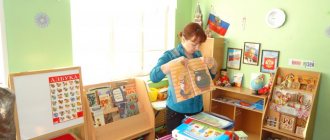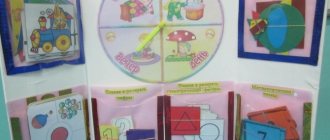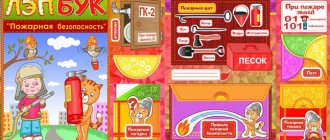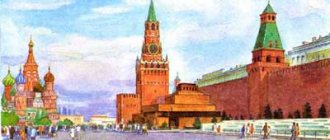Lapbook “My Motherland - Russia”
Maria Bikeeva
Lapbook “My Motherland - Russia”
In our kindergarten there is a competition for the best Center for Patriotic Education of Children. The highlight of our .
To make this laptop we needed the following materials:
- two factory-made “Thesis” folders, purchased at a stationery store, A4 format;
- thick self-adhesive film from a hardware store;
— plastic envelopes A6 format (vertical and horizontal);
— printed and laminated pictures on the laptop theme;
- manicure sticks;
- double-sided and regular tape.
For the base of the lapbook, we glued together 2 “Thesis” folders so that we got the middle (widest) part of the lapbook and two doors (narrower ones). Double-sided tape was used for gluing.
Then the inside of the laptop was covered with thick self-adhesive film in blue, red, yellow and green colors.
The outer side of the laptop contains the title (left flap).
Map of Russia (right wing).
On the back there are symbols of Russia and two games.
"Find the Russian flag."
"Find the coat of arms of Russia."
Pockets for flags and coats of arms are made of laminated tinted paper, glued with double-sided tape.
Flags and coats of arms are manicure sticks and printed laminated pictures, secured with the same tape.
The interior of the lapbook contains various teaching materials placed in plastic envelopes that were originally pressed, but the top of the envelope was cut off for ease of use. The envelopes were glued with double-sided tape, and the name of the game was attached to the top (for clarity).
Left wing.
Middle.
Right wing.
On the left is a portrait of the President of Russia, small photographs “Sights of Russia”, an accordion “Defenders of the Fatherland” and a mini-presentation “Golden Ring of Russia”. The accordion is made using regular tape.
The middle part of the lapbook contains pictures “Russian folk crafts”, a pocket “Holidays and memorable dates”, puzzles “Russian folk patterns”, a game “Find a Russian folk costume”.
On the right is the game “Tell a fairy tale using pictures”, the game “Who lives where?”, the game “Whose trace?”, the accordion “Russian Forest”.
Our lapbook can be used both in individual and subgroup work with students. And the collected material helps solve various problems of patriotic education of preschoolers.
Methodical manual “Lapbook on moral and patriotic education of older preschoolers”
Toolkit
LAPTOP BOOK ON MORAL AND PATRIOTIC EDUCATION
Direction
– Moral and patriotic education
Educational institution
- Kindergarten
Age group
– Senior preschool age (5-7 years)
Lapbook theme
- “Our Motherland”
Author-compiler
—
Nalivaiko Anna Olegovna
(teacher of the State Institution of the LPR “Lugansk preschool educational institution of a combined type nursery-kindergarten No. 107 “Ship”)
Relevance of the chosen topic:
The topic “Moral and Patriotic Education of Preschool Children” is closely intertwined with the concept of “my Motherland”. The child should understand as early as possible that his homeland is a country with its own state symbols and holidays, and national traditions.
The relevance of patriotic education is to raise children in the spirit of love for their homeland and respect for values, attachment to the place of their birth, pride in their people.
Target:
formation of ideas and systematization of knowledge about the Motherland (LPR) and the small Motherland (Lugansk)
Tasks:
1. To form and consolidate knowledge about the head of state, state symbols, and the meaning of one’s native land for a person;
2. Continue to get acquainted with small folklore genres, with poems about your hometown;
3.Enrich the active vocabulary with new words, encourage children’s curiosity;
4. Introduce children to the sights (monuments, architectural buildings) of their hometown;
5. Develop cognitive abilities;
6. Develop patriotic feelings: love for the native land, careful attitude towards its natural resources, respect for people’s work.
Contents of the manual:
Page 1. Title of the manual
1 BLOCK “LUGANSK PEOPLE’S REPUBLIC”
Page 2.
Portrait of the head of the Lugansk People's Republic Leonid Pasechnik. State flag of the LPR, coat of arms.
Target:
formation and consolidation of knowledge about the head of state, consolidation of knowledge about color, the sequence of colors in the state flag, and the meaning of each of them. Contribute to the consolidation of knowledge of the flag and coat of arms of your country.
Page 3.
Anthem of the Lugansk People's Republic. Proverbs about the Motherland.
Target:
development of auditory perception, attention and patriotism, continue acquaintance with small folklore genres, the meaning of the native land for a person, the importance and need to protect and appreciate one’s homeland.
Page 4.
Fauna and flora of the native land
Folder “Red Book of the LPR”
(endangered plants, insects, birds and animals).
Goal: to introduce rare representatives of the flora and fauna of the native land, talk about the significance of the Red Book, and cultivate a caring attitude towards nature.
Natural resources of the native land.
Goal: to study the minerals of the native land, their significance in people’s lives (professions related to resource extraction; significance in different areas of application of the resource, rarity in the world).
D/i “Find an animal by silhouette”
Goal: to introduce representatives of the animal world of the Lugansk region, to develop perception, attention and memory.
2. BLOCK “HOME TOWN LUGANSK”
Page 5.
Folder “Famous people of Luhansk region”.
Goal: to introduce children to cultural and artistic figures who glorified their native land (actors, singers, poets, architects, sculptors), military personnel (World War II participants), athletes, scientists.
Poems about hometown
Goal: to introduce the small homeland and its attractions through artistic expression.
Page 6.
Didactic game: "The third wheel."
Goal: to acquaint children with the symbols of their native country, to teach them to distinguish the flag and coat of arms of the Lugansk People's Republic from among the flags and coats of arms of other countries.
Didactic game: “Puzzles”.
Goal: to consolidate children’s knowledge about the symbols of the LPR and the city of Lugansk (the flag, coats of arms), what is drawn on the coat of arms and what it means.
Page 7.
Portrait of the head of the Lugansk city administration, Manolis Pilavov. Coat of arms of the city of Lugansk.
Target:
formation and consolidation of knowledge about the head of the city, consolidation of knowledge about the meaning of the elements of the coat of arms. To help consolidate knowledge of the coat of arms of your small homeland.
Page 8
Board games “Travel around your hometown”
The set includes 3 fields: “Travel along Sovetskaya Street”, “Travel along Oboronnaya Street”, “Travel to interesting places in the city of Lugansk”.
Goal: to introduce children to the sights (monuments, architectural buildings) of their hometown, to form and consolidate knowledge about the sights.
The methodological manual covers 4 educational areas of preschool education according to the Federal State Educational Standard:
Cognitive development
– acquaintance with the state symbols of the republic and the city of Lugansk; with the main attractions of the city, famous personalities, minerals and the Red Book of the LPR.
Speech development
— the world of native speech through artistic expression, folklore (poems about Lugansk, proverbs about the Motherland).
Social and communicative development
– development of cognitive activity, development of a sense of patriotism.
Artistic and aesthetic development
– study of the anthem of the LPR, photographs of their hometown.
This teaching aid can be used in different types of activities: in direct educational activities, with a group of children, in classes in subgroups, in individual activities and training, in independent activities of children.
Lapbook as a means of moral and patriotic education of preschool children
“Lapbook as a means of moral and patriotic education of preschool children”
Teacher-speech therapist MADOU No. 48, Tomsk Ivanova Yulia Nikolaevna
Goal: Development in preschoolers of moral and patriotic feelings based on familiarization with the history of their country.
The proposed material will help to form in preschoolers the first feelings of patriotism: pride in their Motherland, love for their native land, respect for traditions.
At the beginning of the lesson, children are shown a laptop - the tower with the chimes on Red Square (a three-dimensional figure, inside of which, visual teaching material on this topic is presented, divided into blocks). Also near the tower there is a “Mini-book about Red Square” with illustrations.
Contents of the laptop:
1.
Block No. 1 : “Mini-book about Red Square”, which contains a description and photographs of: Red Square, the Moscow Kremlin, the Spasskaya Tower, the Lenin Mausoleum, the Kazan Cathedral, the Kremlin Palace, the Alexander Garden, Lobnoye Mesto, the Monument to Minin and Pozharsky, St. Basil's Cathedral, GUM.
Goal: to tell what buildings are located on Red Square and what historical value they have.
2.
Block No. 2. Globe.
Information about Russia: area ,
· Population,
· capital, head of state,
· official language,
· ethnic layer,
· currency.
Goal: use a model of the globe to show children that Russia is located on two continents - Europe and Asia. Compare with the area and location of other countries.
3.
Block No. 3.
· Portraits of Russian presidents (from 1991 to the present): B.N. Yeltsin, V.V. Putin, D.A. Medvedev, V.V. Putin.
· Flag of Russia. We consolidate knowledge about color, the sequence of colors in the Russian flag and the meaning of each of them.
· Hymn text.
· Coat of arms, description of the meaning of the image.
Goal: formation and consolidation of knowledge about the president of the country, flag, anthem, coat of arms.
4.
Block No. 4. Models of flags of different countries are presented.
Goal: Getting to know the flags of the countries of the world. Developing the ability to find the Russian flag among the flags of the world.
5.
Block No. 5 . The main holidays of the country (presented in the form of little books).
6.
Block No. 6 “Proverbs and sayings about the Motherland”.
Cards with proverbs and an explanation of the meaning of the proverb are presented. Goal: develop attention, memory, teach to listen carefully. Introduce oral folk art.
7.
Block No. 7 “Monuments of the country”: Monument to St. George the Victorious (Moscow), Monument to Peter I (Moscow), Monument “Alyosha” (Murmansk), Monument to the Conquerors of Space (Moscow), Monument to the Millennium of Russia (V. Novgorod), Monument to the Worker and collective farmer (Moscow), Monument to the Bronze Horseman (St. Petersburg), Monument to the Motherland Calls (Volgograd), Monument to the Flooded Cities (Sevastopol).
Goal: to introduce children to the country’s monuments, to know the history of origin, the purpose of constructing monuments, to introduce them to the heroes and their actions.
8.
Block No. 8 .
Cards with riddles and a picture of the answer on the other side. Goal: development of logic, thinking, speech development.
“A riddle provides a useful exercise for the mind” Ushinsky K.D.
9.
Block No. 9 . Cards with puzzles and an answer picture on the other side.
Goal: development of logic, thinking, speech development.
conclusions
Thanks to this form of work, children learned a lot about their small homeland, they know and enjoy reading poems by heart, they reason about the meaning of sayings and proverbs, they know the heroes of our country. Such an unusual presentation of material will definitely attract the child’s attention. In the future, we plan to continue working on this topic, because I believe that patriotism is the main feature of our people; it helps to cultivate feelings of love for family, the Motherland and the world around us.
Expected results:
1. To develop children’s knowledge about the architecture on Red Square and the history of their creation;
2. Learn information about the coat of arms, anthem, and flag of Russia. Learn about the presidents of Russia from 1991 to the present;
3.Be able to show the territory of the Russian Federation on a map; name the capital;
4.Get acquainted with the flags of other countries of the world;
5. Get acquainted with oral folk art using the example of proverbs and sayings;
6. Get information about the most famous monuments of the country. Know the history of origin, the purpose of creation;
7. Know the heroes of the country;
8. Know the main holidays of the country and celebration traditions.





